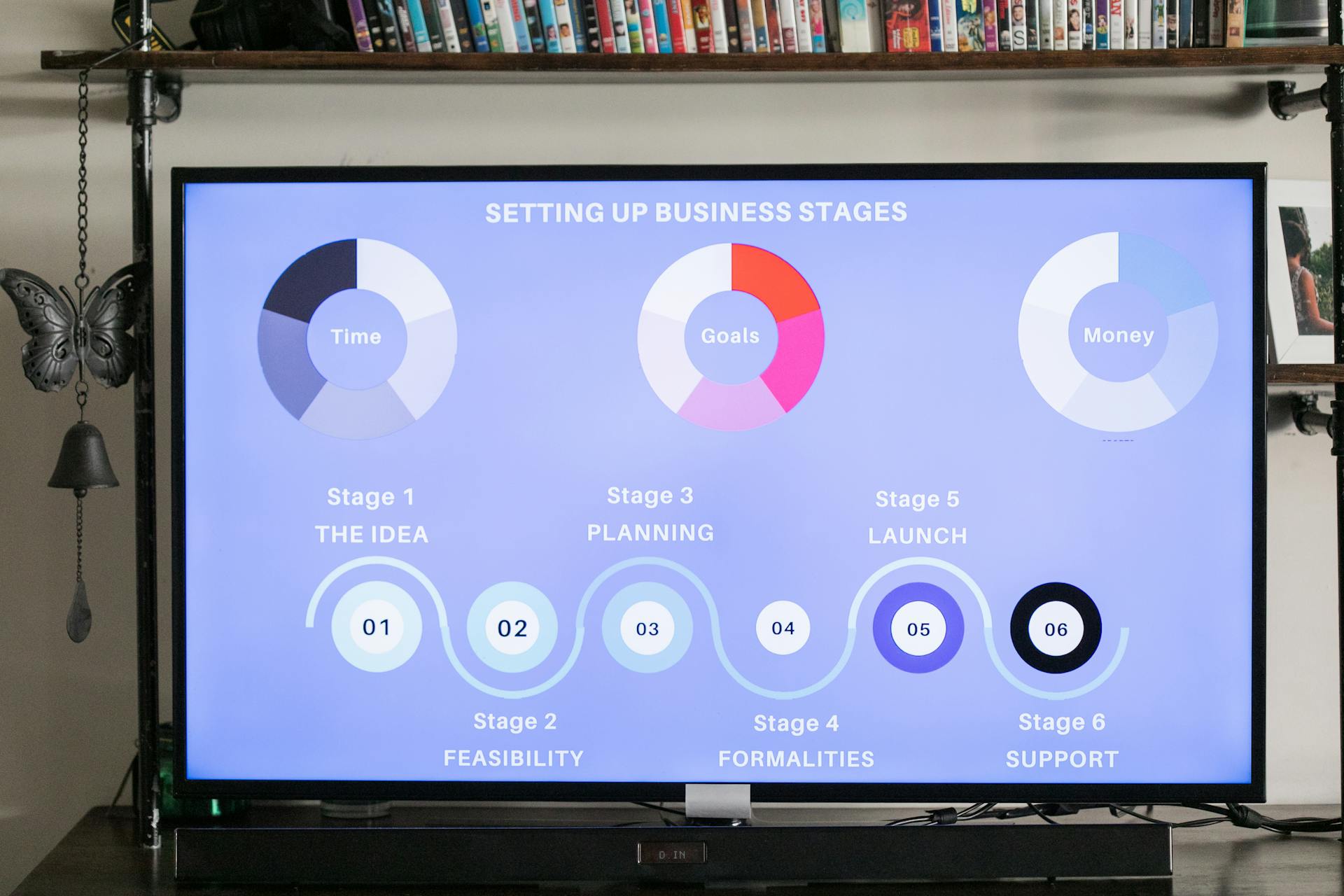
ESPP on paystub can be a bit confusing, but understanding it is easier than you think. You can find ESPP details on your paystub, typically in a separate section or line item.
Your company may offer an Employee Stock Purchase Plan (ESPP), which allows you to buy company stock at a discounted price. This is usually done through payroll deductions.
Some companies may offer a 5% discount on the stock price, while others may offer a 15% discount. It's essential to check your ESPP plan details to know what discount you're eligible for.
Check this out: Self Insured Medical Reimbursement Plan
Employee Stock Purchase Plan (ESPP)
An Employee Stock Purchase Plan (ESPP) is a great perk offered by many companies to their employees. It allows you to buy company stock at a discount, often between 5%-15% off the fair market value.
You can contribute to an ESPP through payroll deductions, and the accumulated contributions are used to buy company shares at the purchase date. This can be a fantastic way to share in the growth potential of your company's stock.
The discounted price you pay for the stock is known as the offer or grant price. This is the price at which the company purchases the shares on your behalf, or the stock price at the time you started contributing to the fund, whichever is lower.
You get to keep the stock in your name until you decide to sell it. At that point, you'll need to think about taxes, specifically a qualifying disposition.
How ESPP Works
An ESPP works by allowing you to purchase company stock at a discounted price, often between 5-15% off the fair market value.
You make your contributions into the plan via payroll deductions, and on set dates, the company purchases shares on your behalf with the funds accumulated and delivers them to you. Participation is optional for employees.
The period of time during which your payroll deductions accumulate to purchase shares on your behalf is called the offering period. This can range from a few months to a year.
For another approach, see: Flex Spending Account Deductions
A purchase period is a shorter time period within the offering period, where you set aside money to purchase shares. For example, a 12- or 24-month offering period may include a series of purchase periods.
The date at the end of the purchase period on which shares are purchased for you is called the purchase date. This is the date when the company uses the accumulated funds to buy shares on your behalf.
You can sell your ESPP shares right after you purchase them or hold onto them. The price you pay for the shares on the purchase date is called the purchase price, and it's typically set at a discount to the stock price.
Here's a breakdown of the ESPP process:
- Enroll in the plan
- Set aside money each month
- Purchase shares at the end of the purchase period
- Sell shares
The price you pay for the stock is the stock price at the time you started contributing to the fund, or the stock price at the time your employer purchases the shares on your behalf, whichever is lower, with a discount of up to 15%.
Worth a look: Does Amazon Pay Out Vacation Time
Participating in ESPP
Participating in ESPP is a straightforward process. You can choose the percentage of your paycheck you wish to contribute to your ESPP, and your company will deduct those contributions from your net (after-tax) paycheck.
Your enrollment will typically roll over from one purchase period to the next unless you change it. This means you can set it and forget it, letting your contributions accumulate over time.
Your contribution level will be based on your gross (before-tax) pay amount, so if you earn $2,000 per paycheck and contribute 10%, $200 will be deducted from your paycheck each pay period.
Additional reading: Espp 2 Year Rule
Participating in an ESPP
Participating in an ESPP is a straightforward process. You simply choose the percentage of your paycheck you want to contribute, and your company will deduct those contributions from your net paycheck.
Your employer will hold those contributions in a company account until the purchase date and make the purchase on your behalf. This means you don't have to lift a finger after setting up your contributions.
Broaden your view: What Is Group Term Life on My Paycheck
The percentage you choose to contribute will be based on your gross pay amount. For example, if your paycheck is $2,000 and you elect to contribute 10% of your pay to your ESPP, $200 will be deducted from your paycheck each pay period.
You can also continue to participate in an ESPP from one purchase period to the next unless you change your enrollment. This makes it easy to make a long-term investment in your company's stock.
Federal tax rules limit ESPP purchases to a maximum of $25,000 worth of company stock per calendar year. This is an important limit to keep in mind when planning your ESPP contributions.
Intriguing read: How Much to Contribute to Espp
Qualified
If you're participating in an ESPP, you'll want to understand the Qualified type. A qualified ESPP is designed and operates according to Internal Revenue Section (IRS) 423 regulations.
There are two classifications of sales for qualified ESPPs: Qualifying Disposition (QD) and Disqualifying Disposition (DD). A QD occurs when you hold shares over 1 year after the purchase date and over 2 years after the offering date, while a DD occurs when you hold shares less than 1 year after the purchase date or less than 2 years after the offering date.
A fresh viewpoint: Espp Offering Date
No tax is chargeable at purchase in both QD and DD cases. This means you won't owe taxes when you buy shares through your ESPP.
At the sale, ordinary income and capital gains are taxed. If a QD occurs, gains are considered long-term where the tax rate is typically lower than ordinary income. If a DD occurs, gains are considered short-term and are taxed higher.
Here's a comparison of Qualified and Non-Qualified ESPPs:
| Criteria | Qualified ESPP | Non-Qualified ESPP |
|---|---|---|
| Design and operation | Acc. to IRS 423 regulations | Does not meet IRS criteria |
| Discount range | 0% to 15% | More than 15% |
| Shareholder approval | Required | Not required |
| Taxation | More favorably | Less favorably |
| Flexibility | Less flexible | Flexible |
Key ESPP Details
ESPPs are a great way to buy company stock at a discount, and here's how it works. You contribute a percentage of your paycheck to a stock purchase fund through payroll deductions over a set period.
The percentage you choose to contribute will be based on your gross (before-tax) pay amount, and your employer will deduct those contributions from your net (after-tax) paycheck.
Here are some key details to keep in mind:
- ESPPs let you buy your employer's stock at a discount, often up to a 15% reduction.
- The stock is bought at the lower of the stock price at the start of the contribution period or at the time of purchase.
- Taxes on the discount are owed when you sell the stock, and the discount is taxed as regular income or capital gain depending on how long you hold the shares.
- ESPP purchases are limited to a maximum of $25,000 worth of company stock per calendar year.
Key Takeaways
ESPPs offer a significant discount on stock purchases, often up to 15% off the market price.
You'll contribute to a stock purchase fund through payroll deductions over a set period, which can be a convenient and automatic way to save for your future.
The stock is bought at the lower of the stock price at the start of the contribution period or at the time of purchase, which can be beneficial if the stock price drops during the contribution period.
Here are the key tax implications to keep in mind:
- Taxes on the discount are owed when you sell the stock.
- The discount is taxed as regular income if you sell the shares within a year of purchase.
- The discount is taxed as capital gain if you hold the shares for more than a year.
Qualified & Non-Qualified
There are two types of ESPPs: Qualified and Non-Qualified. A Qualified ESPP is designed and operates according to Internal Revenue Section (IRS) 423 regulations.
A Qualified ESPP offers a discount range from 0% to 15%, with 15% being the most commonly used. In contrast, a Non-Qualified ESPP may offer a discount of more than 15% from the current FMV of the stock.
A Qualified ESPP is more favorably taxed than a Non-Qualified ESPP. Shareholders must approve a Qualified ESPP, but this is not required for a Non-Qualified ESPP.
For your interest: Qualified Espp
Here's a quick comparison of the two:
| Feature | Qualified ESPP | Non-Qualified ESPP |
|---|---|---|
| Design | Acc. to IRS 423 regulations | Does not meet IRS criteria |
| Discount | 0% to 15% | More than 15% |
| Shareholder approval | Required | Not required |
| Taxation | More favorably | Less favorably |
| Flexibility | Less flexible | Flexible |
A Qualified ESPP has two classifications of sales: Qualifying Disposition (QD) and Disqualifying Disposition (DD). No tax is chargeable at purchase in both QD and DD cases.
Expand your knowledge: Espp Disqualifying Disposition W2
p.article.sections.frequentlyAskedQuestions
What percentage of my paycheck should go to ESPP?
Typically, 10-20% of your gross salary is contributed to an ESPP. This percentage is based on your annual salary before taxes or withholdings are deducted
p.article.sections.sources
- https://www.fidelity.com/learning-center/personal-finance/what-is-an-ESPP
- https://www.morganstanley.com/atwork/employees/learning-center/articles/how-does-espp-work-your-guide
- https://turbotax.intuit.com/tax-tips/investments-and-taxes/employee-stock-purchase-plans/L8NgMFpFX
- https://www.globalshares.com/insights/employee-stock-purchase-plan-espp/
- https://www.oysterhr.com/glossary/employee-stock-purchase-plan
p.article.featuredImages pexels.com



